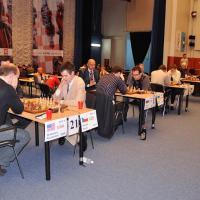
World Cup: Ups and Downs
Exchanges play an important role in modern chess. Even though the chess that we see today is marked by heavy pre-analysis by computers and superb opening preparation, it has not lost its positional elements. When one decides which pieces to exchange, one must weigh many factors -- both positional and tactical. Currently, there is a world class tournament taking place in Khanty-Mansiysk (oh, those Russian names for the cities, so easy to spell!!)-- The World Cup. Being an American I am rooting for the American chess players (naturally), but unfortunately there is only one remaining (if I did my math correctly) -- Gata Kamsky. The tournament is widely covered by different websites and you can check it out yourself. I would like to present and discuss some examples of piece exchanges that have happened during the tournament. Overall, the quality of the games played at World Cup is high but in the end there are many blunders due to time pressure and the overall stress of the tournament. When matches end tied 1-1, tiring struggles can ensue. For example, Varuzhan Akobian played 16 (!) games against P. Tregubov. Varuzhan was able to fight through 9 hours of insanity in order to secure victory in the match.
Let us look at the first example. This was the game that started the marathon match of Akobian-Tregubov. If you look through the game it seems that white won effortlessly, as his attack was very natural. One of the reasons for black’s loss, I think, is the decision to exchange the knight on c6- a very important defender of the king.
The following game was from the second match of the second round. The first game ended up in a draw, thus this game could have decided who will advance into the third round. There were many pieces eliminated in the first half of the game. The opponents were very careful of what pieces to leave and what to destroy. After massive exchanges the position was about equal but then white pushed too hard on the queenside. This is understandable, since he likely was not eager to play a playoff the next day if the game ended in a draw. One can praise Shabalov’s patience and a wise choice of an opening to provoke the opponent for aggressive actions that gave him chances to win the game. At some point black were just totally winning but did not find the best moves and the game ended up in a draw.
The following example demonstrates piece dynamics in the King’s Indian. It is a rule that if white establishes the knight on e4, locking the bishop on g7 behind the pawns then black is in trouble. Any endgame will favor white. One still needs to have good technique to convert the advantage… this is well portrayed in the game. White builds a large advantage, and black's fate is sealed upon blundering a piece. This is not typical to such high class chess but remember that World Cup is an extra stressful event due to elimination format.
I hope you continue to enjoy the games from the event as much as I do, as there is still about a week of chess to be played. I look forward to seeing who will win the event…I wonder who are the readers' favorites? I'll make a wild prediction that Shirov will win it… I just like his style. My friend IM Irina Krush does not agree with my prediction-- her pick is Mamedyarov. I also hope that you had a nice Thanksgiving… As for me, this weekend will be full of chess as I head to National Congress tournament in Philadelphia.



